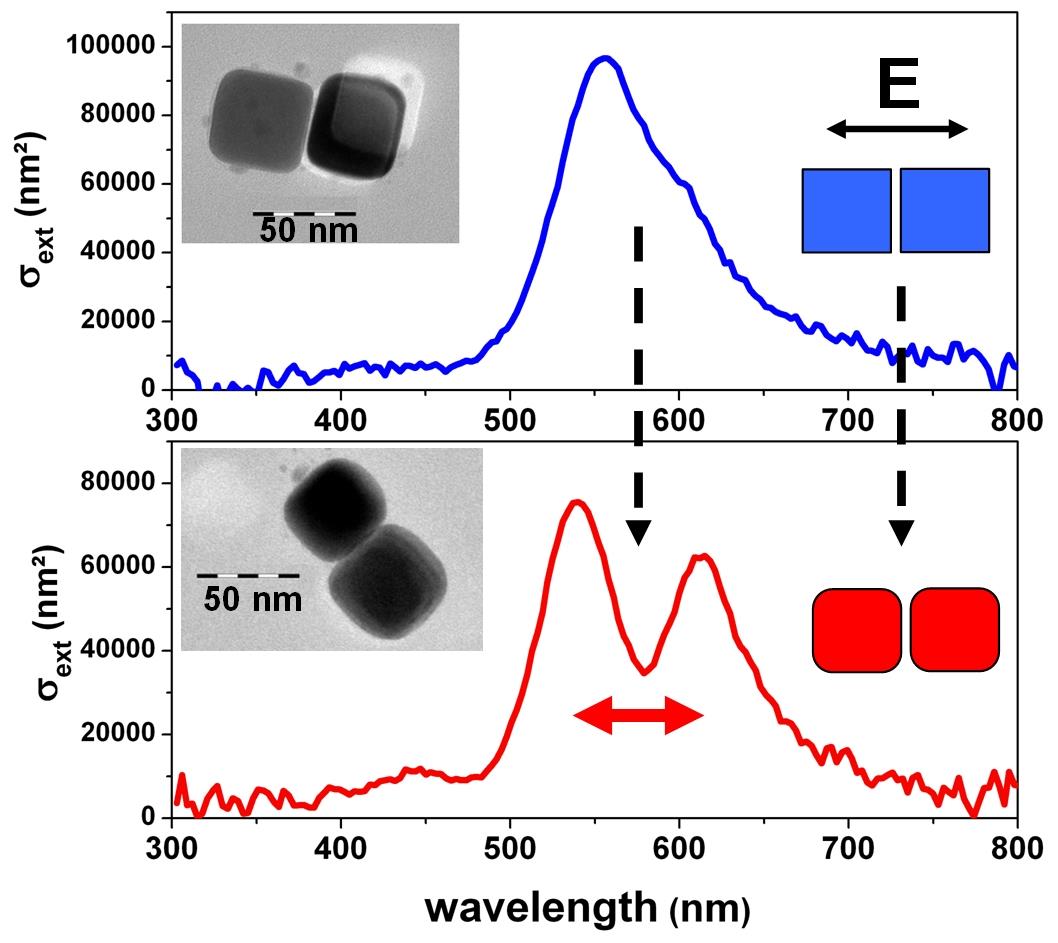Scattering and extinction of single nano-object correlated by electron spectroscopy
This topic of research concerns the study of linear optical properties of individual metallic nanoparticles, especially their Localized Surface Plasmon Resonance (LSPR) response due to the collective excitation of the conductive electrons. Our team has developed ultrasensitive set-ups to measure absolute extinction cross sections or quantitative scattering [Billaud 2010, D.Manchon, Ph.D. Thesis 2012] of a single nano-object over a wide spectral range (300 nm to 1700 nm). The high sensitivity required is obtained by a periodic movement of the nano-object in the focused light beam, associated with a lock-in detection system (SMS - spatial modulation spectroscopy). Also the optically studied nano-objects can be characterized by electron microscopy (transmission or scanning microscopy), allowing a detailed understanding of the optical response of the studied objects directly with their morphology. This correlation with electron microscopy is difficult and is mastered by very few teams, but it is essential for the interpretation of the experimental results.
Plasmon coupling: pairs of interacting nanoparticles
The combined approach of optical spectroscopy and electron microscopy has underlined the importance of the morphology of the interparticle area for dimers, consisting of two NPs in the strong coupling plasmonic regime (low interparticle distance). In this regime, the optical spectra are very sensitive to the interparticle distance for an excitation light polarized along the major axis of the dimer. The main effects consist into a “red-shift” and an amplification of the LSPR as the interparticle distance decreases [Marhaba 2009, Izquierdo-Lorenzo 2013]. For dimers of gold and silver spheres, the experimental results are in good agreement with predictions based on the generalized Mie theory. However, in some cases, there was a singular extinction spectra suggesting that both particles are in a state of partial overlapping of their electron clouds (“spill-out” effect). For dimers of silver nanocubes, a duplication of the RPS is observed for small interparticle distances with the appearance of a spectral “hole burning” (i.e. an induced transparency in the plasmon band, fig. 1). The correlation between the optical and electron microscopy measurements and simulations has allowed us to understand this phenomenon, which is related to the degree of trimming of the edges of the cubes [Grillet 2011].
Fig. 1: Absolute optical extinction of dimers of silver nanocubes.
Nano-antenna based on transition metal
Nano-antennas studied previously are mostly based on gold or silver. The use of other chemical elements such as transition metals would open new opportunities for applications of plasmonics. However, it is only in systems of several hundred nanometers and/or highly anisotropic that plasmon resonances emerge in the visible-near IR. A mean of revealing RPS while maintaining reasonable size NPs (~50-100 nm) is to exploit the plasmon coupling between interacting NPs. Calculations of extinction cross section of dimers of spherical NPs of 100 nm in diameter spaced about ten nanometers clearly show SPR in the visible or near IR for excitation along the major axis of the dimer, almost for all transition metals. In this respect optical measurements and SEM observations of nano-antennas lithographed Pt, Pd and Cr (developed by the Nanophotonics team INL) , made it possible to systematically identify a phenomenon of plasmon coupling showing the possibility to extend plasmonic virtually to all transition metals [D. Manchon, Ph.D. Thesis, 2012 TomBapic project must LABEX I- 2012-2013].
Nano-objects for bio-sensing and environmental studies
Plasmon response of metal nanostructures is very sensitive to their immediate environment particularly at "hot spots" (areas of high local field amplification), their position, number and intensity can be optimized by a suitable choice of morphology. Such objects can be used as plasmonic sensors in the liquid (biosensing) or gas phase. In addition to classical nano-antennas, we are interested in more complex objects, anisotropic, such as bipyramids and nano-gold stars which exhibit SPR in the near IR transparent area of biological tissues. Systematic optical studies combined with structural characterization by electron tomography (size, aspect ratio, peak) were conducted on gold bipyramids chemically synthetised (Team Functional Materials and Photonics, ENS Lyon) [Navarro 2012a, 2012b , ANR nanoPDT 2010-2013]. Also the first studies of sensitivity of the SPR to the environment were made on the oxidation of silver nanoparticles (spherical or cubic NPs). Real-time measurements allowed us to observe photo-oxidation process by correlating the evolution of the optical response to the structural and chemical changes of the objects (oxidation and trimming cubes) [Grillet 2013].


















